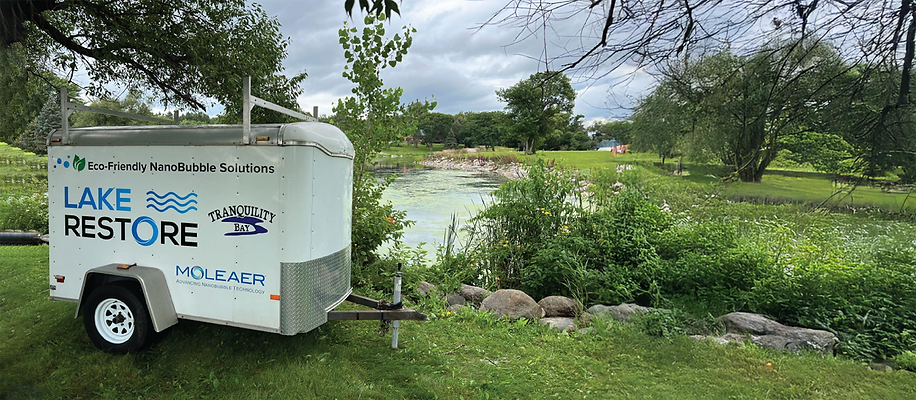How do Nanobubbles Destroy Algae and Muck?
- Chad Woolson
- Jun 27, 2022
- 2 min read
Updated: Jun 5, 2023
Among many other benefits, nanobubble generators can serve as a long term solution for mitigating and eliminating algae and muck in ponds. These benefits are mainly due to the minuscule size of nanobubbles (5000x smaller than a grain of sand). Nanobubbles are so tiny that they are neutrally buoyant in water. This allows these oxygen bubbles to rapidly dissolve in water, with an 85% oxygen transfer efficiency. Dissolved oxygen (DO) levels increase rapidly when water is injected with nanobubbles.
The Cycle of Algae and Muck Growth

Although the growth of algae and the accumulation of muck might seem like separate issues, they are quite closely related. They are both direct signs of the eutrophication process of a lake. All lakes start as oligotrophic lakes, characterized by clear water and a high dissolved oxygen level. Over time, plant matter, animal waste, and nutrients accumulate and decompose into organic sediment (muck). Muck is used as a food source for algae to grow and multiply. When algae reach the end of life, they decompose (a process that consumes oxygen) and add to the muck in the lake while also removing oxygen. Aerobic (oxygen-requiring) bacteria consume and convert muck into more dense material that sinks to the bottom of the pond, but can only function in a high DO environment. All of these factors cause an exponential feedback loop that results in a thicker muck layer, greater concentration of algal blooms, and murky water.
How Do Nanobubbles End The Cycle of Nutrient Production?
Nanobubble Generators inject billions of nanobubbles into the water column per second, with the smallest available unit (Kingfisher) treating 40 gallons of water per minute or 57,600 gallons per day. Thanks to this impressive efficiency, nanobubble generators can increase the DO to saturation (at room temperature, water can dissolve oxygen up to 8 ppm) in under a month when used correctly (1,2,3).
Thanks to this rapid increase in dissolved oxygen, nanobubble generators nurture the ideal environment for aerobic, muck-digesting bacteria to function. These bacteria consume the organic matter and nutrients that muck is composed of and convert it into water, carbon dioxide, and dense materials that sink to the bottom of the lake and foster a hard bottom.
For more information on pond muck and how to remove it, Click here.
By eliminating the muck layer as well as sediment suspended throughout the water column, algae and other plants are starved of the nutrients they require to grow and proliferate. When lacking these nutrients, the concentration of algae within a pond steadily reduces. When algae die, their cells consume oxygen and add to the muck layer, where bacteria digest them to prevent further buildup. The nanobubbles also immediately replace the lost oxygen to retain oxygen saturation.
Nanobubbles are also the bane of blue-green algae. Not only do nanobubbles reduce the available nutrients for toxic blue-green algae to multiply, but when cyanobacteria encounter nanobubbles, the nanobubbles have a lysis effect on the cyanobacteria, exploding and rupturing their cell wall to trigger cell death.
Click Here to Get your hands on a state-of-the-art Nanobubble Generator today and end your algae problems!






Comments